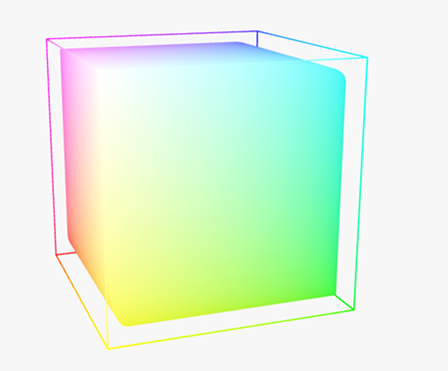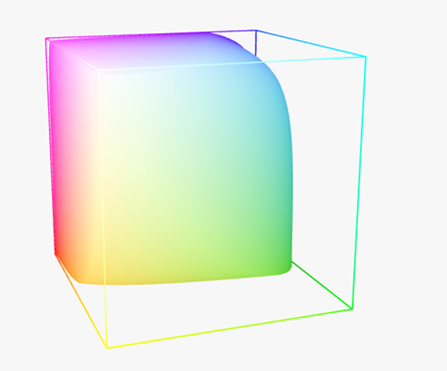Specification and reference implementation are already widely adopted; Further industry feedback invited on first release.
Beaverton, OR – May 16, 2024 – Today, The Khronos® Group, an open consortium of industry-leading companies creating graphics and compute interoperability standards, has released the Khronos PBR Neutral Tone Mapper specification and sample implementation. Khronos PBR Neutral is specifically designed to display 3D assets rendered using physically-based rendering (PBR) with true-to-life colors that are vital in applications such as eCommerce, architecture and CAD. The Khronos PBR Neutral Tone Mapper is already enjoying wide adoption and support by 3D tools and engines including <model-viewer>, Autodesk, Babylon.js, Blender, Dassault, Filament, London Dynamics, Phasmatic, Three.js, and Threekit.
Khronos PBR Neutral enables faithful reproduction of a product’s base color, hue and saturation when using PBR rendering under grayscale lighting, while eliminating HDR artifacts around highlights. It complements tone mappers such as ACES, which are intended for use with other types of content such as images with wide input color gamuts, or are used to achieve stylized artistic looks used in the film, visual effects, and gaming industries.
Tone mapping is often omitted in pipelines that struggle to accurately render the color of assets, but this does not work well with content using HDR or physical lighting. Artists using Khronos PBR Neutral can expect the output of any end-point PBR-based renderer that has adopted the tone mapper specification to faithfully reproduce desired base and brand colors. Khronos PBR Neutral is designed to be simple to implement and fast to run. The sample implementation contains just 13 lines of GLSL shading language code. The specification also supports analytical inversion of the tone mapping function.
While initially developed to support workflows based on the Khronos glTF™ 3D asset format, the Khronos Neutral Tone Mapper is file format-agnostic. The tone mapper currently supports output to sRGB, and Khronos aims to expand support for additional outputs in future releases. Khronos is also discussing future glTF exposure controls to support precise setting of real-world lighting values that can be essential for accurate display of asset colors.
“A common pain point in 3D content creation is achieving vivid, real-life colors for 3D objects using physically-based rendering. The Khronos PBR Neutral Tone Mapper enables everyone in the content production pipeline to create and display accurate, photorealistic models.” Emmett Lalish, staff software engineer, Google and Khronos Group glTF and 3D Commerce Working Group member.
Khronos has released the Khronos PBR Neutral specification into open source and welcomes community feedback and suggestions for future enhancements via the Khronos PBR Neutral Tone Mapper GitHub repository. Content creators, artists, implementers, and engine developers are encouraged to test the Khronos PBR Neutral sample implementation interactively using their own glTF assets and lighting to determine if it is a good fit for their use case and report feedback and issues on GitHub.
An interactive comparison of various tone mappers, including Khronos PBR Neutral, is available at https://tone-mapping.glitch.me/. The Khronos glTF Sample Viewer also supports Khronos PBR Neutral under ‘Advanced Controls, Tone Map’.
Anyone interested in additional information on the background, design goals and implementation details of Khronos PBR Neutral is encouraged to read the Tone Mapping Considerations for Physically-Based Rendering article by Google staff software engineer Emmett Lalish.
Khronos will also host a free webinar, “How to Achieve True-to-Life 3D Color Rendering with the Khronos PBR Neutral Tone Mapper” on Thursday May 30, 2024 at 10:00 AM PT. Register to attend.
The Need for PBR Neutral Tone Mapping
One of the challenges of displaying true-to-life assets using traditional filmic tone mappers such as ACES is the limited range of reachable colors, especially when outputting bright yellow, green, or cyan hues to an sRGB screen such as a standard computer monitor or mobile device. As a result, 3D objects displayed with filmic tone mapping can appear washed out. Artists often address this problem by not applying a tone mapper at all. This can improve saturation but introduces problems such as hue skew, visual artifacts, or loss of dimension for shiny objects.

The Khronos PBR Neutral Tone Mapper is intended to provide a 1:1 match for colors up to a certain maximum value, with the remainder used as headroom for compressed highlights. This approach allows content creators to preserve base color, texture, and dimension. The following diagram compares the reachable colors for Khronos PBR Neutral versus the popular ACES filmic tone mapper. The cube represents the [0, 1] space in linear light - no sRGB curve has been applied.


The Khronos PBR Neutral Tone Mapper gives artists a new option for creating assets tuned to application needs. Khronos PBR Neutral, linear, and filmic tone mapping each have distinct use cases and advantages:
- Linear tone mapping (i.e. “no tone mapper applied”) works well for models with no HDR input or physical lighting.
- Filmic tone mapping (e.g. ACES, AgX) should be used in strongly HDR scenes, applications with wide input color gamuts, or to achieve specific artistic looks.
- Khronos PBR Neutral is designed for photorealistic physically-based rendering with well-exposed scenes, precise sRGB base color reproduction under grayscale lighting, and un-opinionated representation under colored light such as sunlight.
Removing the Guesswork from Content Creation
The Khronos PBR Neutral Tone Mapper makes it possible to verify a 3D object’s base color independently from the lighting environment, an approach that has advantages for artists, brands, and end users:
- Reduced Guesswork: Artists can verify color values in the texture file; the “guess and check” process of creating a model and testing color output in the final render is eliminated.
- Shorter QA Cycles: The chance of finding color issues in a finished model is reduced, resulting in less rework and fewer delays.
- Faster Updates: An object’s colors can be quickly and easily updated in the asset file without extensive additional QA.
- Flexibility: Marketing and graphic design professionals can vary the lighting environment to achieve their desired look without needing to adjust the base model colors to maintain color fidelity.
Industry Adoption
At launch, the Khronos PBR Neutral Tone Mapper has been embraced by popular 3D web, mobile, and cross-platform glTF PBR renderers, including Filament, Babylon.js, <model-viewer>, and Three.js.
Khronos is working with 3D authoring tool vendors to include native support, and Blender 4.2 Alpha users can already start testing the Khronos PBR Neutral view transform within Blender itself.
An OpenColorIO configuration file (config.ocio) defining an approximation of this tone mapper is included in the specification as a sample implementation to assist authors in trying out the Khronos PBR Neutral Tone Mapper within their existing workflows.
Industry Support
"Tone mapping has been a significant challenge in many content creation pipelines, especially within the eCommerce sector. The Khronos PBR Neutral Tone Mapper effectively addresses some of these challenges, offering users a compelling option, especially for workflows where a 'no tone mapping' approach is currently the norm. We're looking forward to more industry feedback on this initial release and hope to see further work in this area going forward. Through OpenColorIO, the Khronos PBR Neutral Tone Mapper can already be used in several Autodesk products, including 3ds Max and Maya." Henrik Edstrom, distinguished software architect, Autodesk
“It was great working with Khronos on getting the Khronos PBR Neutral Tone Mapper production ready, and to make it available via OpenColorIO for everyone." Ton Roosendaal, chairman, Blender Foundation
"For Dassault Systèmes, virtual twins are the cornerstone of sustainable business innovations across the entire product lifecycle. Visualization in product engineering and commercialization transcends the mere creation of visually appealing content; it's about ensuring authenticity, accuracy and trustworthiness. Tone mapping plays an essential role in bridging the virtual world with our real-world output devices. The Khronos PBR Neutral Tone Mapper represents a significant stride towards achieving authentic and reliable product visualization." Bastian Sdorra, rendering R&D engineer, Dassault Systèmes
“Achieving color, tone and visual accuracy to visualize physical products is one of the toughest 3D challenges in e-commerce today. This became a key focus for the Khronos 3D Commerce Working Group, and we are very excited to launch the Khronos PBR Neutral Tone Mapper to help solve this long standing issue. The results have also been very beneficial for us at London Dynamics, enabling our customers to see their products much more accurately than before without the need for our 3D Artists modifying shaders or lighting artificially to achieve the same results.” Daniel Frith, Chair of The Khronos 3D Commerce Working Group, Vice-Chair of The Khronos 3D Formats Working Group & Chief Creative Office at London Dynamics.
"The Khronos innovative tone mapping solution sets a new standard in digital representation for eCommerce, ensuring that users enjoy vivid, real-life visuals. Phasmatic immediately adopted this technology to enhance its ability to deliver authentic online product experiences." Andreas Vasilakis, CEO and cofounder, Phasmati
“Threekit is impressed with the quality of the results produced by the Khronos PBR Neutral Tone Mapper. For ecommerce applications, presenting true-to-life colors to users on the computer screen is incredibly important, and the new tone mapper from Khronos makes this easier to do." Ben Houston, CTO and founder, Threekit
Getting Involved
The development and rapid uptake of the Khronos PBR Neutral Tone Mapper was made possible by the cross-industry collaboration that takes place within the Khronos 3D Formats and 3D Commerce Working Groups. Content creators, artists, implementers, and engine developers are encouraged to share their feedback, questions, and suggestions for future improvement by engaging with the Working Group on GitHub, Discord, Khronos Discussion Forum, Stack Overflow or X.
Any company can get directly involved in the development of glTF and other Khronos standards by becoming members. Learn more at khronos.org/members.
About Khronos
The Khronos Group is an open, non-profit, member-driven consortium of over 180 industry-leading companies creating royalty-free, interoperability standards for 3D graphics, augmented and virtual reality, parallel computation, vision processing and machine learning. Khronos activities include 3D Commerce™, ANARI™, glTF™, NNEF™, OpenCL™, OpenGL®, OpenGL® ES, OpenVG™, OpenVX™, OpenXR™, SPIR-V™, SYCL™, Vulkan®, and WebGL™. Khronos members drive the development and evolution of Khronos specifications and are able to accelerate the delivery of cutting-edge platforms and applications through early access to specification drafts and conformance tests.
###
Khronos® and Vulkan® are registered trademarks, and ANARI™, WebGL™, glTF™, KTX™, NNEF™, OpenVX™, SPIR™, SPIR-V™, SYCL™, OpenVG™, Karamos™ and 3D Commerce™ are trademarks of The Khronos Group Inc. OpenXR™ is a trademark owned by The Khronos Group Inc. and is registered as a trademark in China, the European Union, Japan and the United Kingdom. OpenCL™ is a trademark of Apple Inc. and OpenGL® is a registered trademark and the OpenGL ES™ and OpenGL SC™ logos are trademarks of Hewlett Packard Enterprise used under license by Khronos. All other product names, trademarks, and/or company names are used solely for identification and belong to their respective owners.
Khronos Group Press Contact:
Alex Crabb, Caster Communications Inc.
401-792-7080

